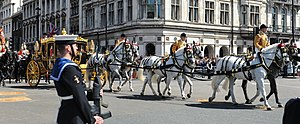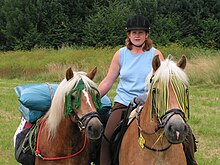Saddle horse and hand horse
The horse in a team that carries a riding saddle is called a saddle horse . It's always on the left. The horse that runs to the right and is not ridden is called a hand horse .
Drive
A ridden team is not steered from the wagon, but from the horse. When driving à la Daumont , the car does not need a buck, this was the case with the military (guns) or with representative teams.
With teams of four, six or up to ten draft horses, steering all pulling animals is a challenge that very few coachmen can sustain, especially in traffic or during parades with large crowds. The weight of the leather leashes increases with every pair of horses, even a four-in-hand horse requires a lot of strength to hold the lines. In order to prevent stagnant progress and accidents, riders are placed on the saddle horses, which are able to reliably steer the group of draft horses in sections or in full (in the absence of their own coachman).
The riders of the saddle horses are called pioneers (formerly also Pikör ). From there he steers the right horse (hand horse) with a rein. Sometimes he drives other horses in front of him. But it is often the case that every pair of horses that is harnessed during a heavy pull or on a mountain has its own pioneer.
horse riding
Hand horses are not only used in driving , but also in equestrian sports . In road traffic , hand horses are generally guided on the right side when riding to prevent them from pushing onto the road .
The hand horse can serve as a pack horse on trail rides . A rider can lead several hand horses and thus bring the animals to another location. Horses that cannot be ridden for various reasons can be carried as hand horses and thus moved. For example, an adult rider can also move a small children's pony. Horses with health problems or horses that cannot be ridden due to their age can run alongside the rider without any strain.
Individual evidence
- ↑ Theodor Zell: Our pets from the point of view of their wild relatives. 1921, p. 115. (Reprint: Salzwasser-Verlag, Paderborn 2014, ISBN 978-3-8460-9497-6 .)
- ↑ Heinrich August Pierer (Ed.): Encyclopaedic Dictionary of Sciences, Arts and Crafts. Volume 12, Literatur-Comptoir, Altenburg 1829, p. 115.
- ↑ Hand horse



